Killers of the Flower Moon movie and the true story of the Osage tribe. Killers of the Flower Moon (2023): plot based on real events, meaning of the movie with Leonardo DiCaprio, explanation of the ending, similar movies.
Country: USA
Genre: drama, history, western, crime
Year of production: 2023
Director: Martin Scorsese
Actors: Leonardo DiCaprio, Lily Gladstone, Robert DeNiro, Jesse Plemons, John Lithgow
The new picture of the cult director Martin Scorsese from the originally conceived detective in the process of production turned into a crime drama or even melodrama. Thus the meaning of the movie Killers of the Flower Moon, its idea underwent changes. According to the first version of the script viewers should have been brought to the unflattering truth of one of the chapters of American history. In the final version we recognize it almost immediately, and the rest of the time we follow mainly the tragic love line of the characters DiCaprio and Gladstone.
What is Killers of the Flower Moon about?
Let’s make a breakdown of the plot of the movie Killers of the Flower Moon.
The action takes place in the twenties of the twentieth century in the state of Oklahoma (USA), in Osage County.
The Osage Indians bury a ceremonial pipe, lamenting the ongoing assimilation of their people into the society of white colonizers.

A jet of oil gushes out of the ground. The Oseiji rejoice – of course they do, because oil makes them, the owners of this land, rich. The newsreel simulation tells us that they have become the richest nation in terms of per capita income. There were, however, limitations (further shown in separate episodes) – including the appointment of white trustees to manage the money of the “incapacitated” Osage people.
Since World War I, Ernest Berhart has been coming to Osage. He is going to work on the reservation with his brother Byron and his uncle William Hale. The latter is called King by everyone in the county. He pretends to be an active Indian benefactor. In reality, the point of all his activities is solely for his own enrichment. In this he agrees with Ernest.
The King suggests Ernest take up with a girl named Molly Kyle. She is an Osage and her family has a good income from oil production. Ernest, who had previously committed numerous armed robberies of Indians, met Molly. He regularly takes the girl in a cab and gradually gets closer to her. The young people get married. The wedding celebration combines elements of Catholic tradition and the traditions of the Osage tribe. In time, the couple has three children.
The king organizes the murder of several Osages. He tells Ernest that he will be able to inherit more property rights if members of Molly’s family are dead. Molly herself is diabetic, and her mother Lizzie is also seriously ill. When Molly’s sister Minnie dies of a strange debilitating illness, the King orders Byron to commit the murder of Anna, Molly’s other sister.
The Osage tribal council of elders blames the whites for the murders and decides to fight back. The king selflessly pretends to support the tribe wholeheartedly and also sincerely wants to find a solution to the strange deaths. The Indians’ concern grows when they see a newsreel with footage of the 1921 Tulsa massacre. At that time, whites burned down an entire black community, killing many of the residents.
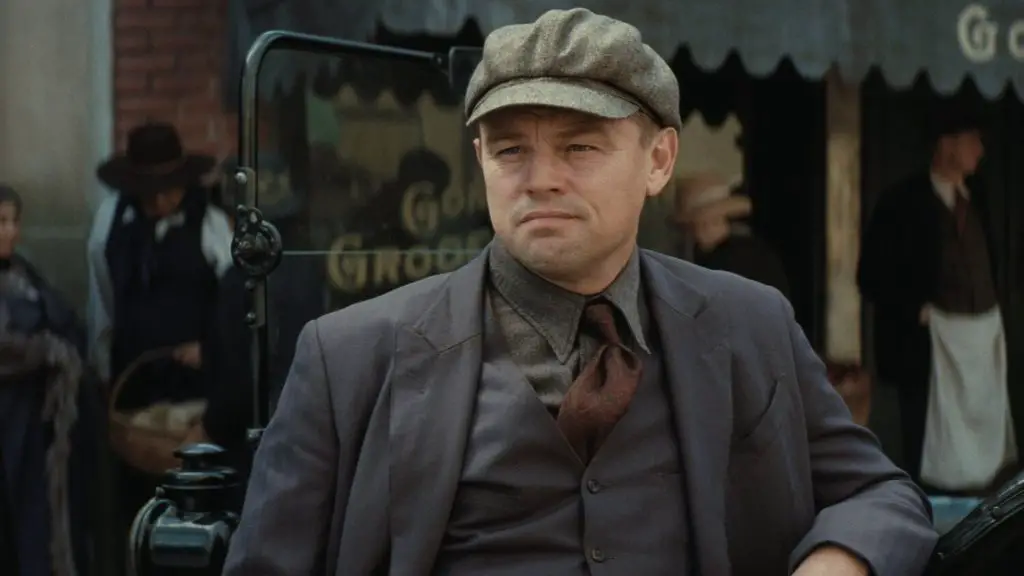
Lizzie is dying. Some time before, she sees an owl in her room – the harbinger of death.
The King orders Ernest to organize a mock suicide of Henry Roan – Osage, who was Molly’s first husband. The point of it is to get his life insurance money. However, Ernest’s sidekick John Ramsey kills Henry in the back of the head, which clearly does not look like a suicide. For this, the King beats Ernest at the Masonic Temple.
Because both the sheriff and the judges of the local court are steeped in corruption, there are no investigations into the Indian murders. An Osage representative who tried to discuss this in Congress is also killed on the King’s orders. Molly finds a private detective named William Burns, but Byron and Ernest beat him up and send him away.
Utterly desperate, Molly goes to the capital as part of a delegation of Osages and appeals to the President personally. Upon learning of this, the King decides to add poison to the insulin he supplies to Molly in order to “pacify the girl”. Ernest is forced to agree. After a while, he injects his wife with poison himself, as she trusts no one but him.
The King gives another order to Ernest. This time he is to organize the murder of Molly’s last living sister, Reta. Her husband must be killed along with her. Ernest instructs Acie Kirby to plant explosives under Retha’s house. The explosion occurs in the night and the murder takes place. Molly now becomes the heir to her family’s property.
The FBI assigns a team led by Thomas Bruce White to investigate the Osage murders. Soon enough, the agents learn the whole truth. The king covers his tracks by framing and killing his associates, but in the end he is still arrested.

Molly is dying. She, as well as her mother, is deliriously visited by an owl, the harbinger of death. However, having arrested Ernest, FBI agents come to the girl’s aid and put her in a hospital. There, Molly gradually begins to recover.
White convinces Ernest to appear in court as a witness against King. This is accomplished through the testimony of an old associate of his named Blackie Thomson, who is in prison for the murder of a policeman. Ernest used him for his own selfish purposes – including getting insurance for the theft of his car committed by Blackie.
King’s attorney Hamilton persuades Berhart to claim torture by agents and not testify against Hale after all.
At the trial, Kelsey Morrison, who killed Anna along with Byron and made a deal with the investigation, calmly recounts his atrocities.
One of Molly and Ernest’s daughters dies of whooping cough. Then Berhart decides to change his testimony again, although the King threatens and urges him not to do so. In court, Ernest tells of the crimes organized by his uncle. After this, Molly meets with her husband. They speak frankly to each other. Molly leaves Ernest when he doesn’t admit to poisoning her.
We are transported to a stage where a radio show is being recorded, the content of which deals with the events that have taken place. The actors talk about the fate of the characters. Both King and Ernest were convicted. They were sentenced to life imprisonment, but after a few years were released early. Byron did not receive a term thanks to the jury. The Shawnee brothers, who gave Ernest poison for Molly and participated in other poisonings, were not convicted because their guilt was not proven. Molly remarried after her divorce from Ernest. She died at the age of fifty and was buried near her family. In the modest newspaper obituary dedicated to her, there was no mention of the Indian murder case (in the movie, Molly’s eulogy is read by director Martin Scorsese himself).
In the end, we see a large Osage ceremony held in modern times.
The real history of the Osage tribe
So, the movie Killers of the Flower Moon is based on the book of the same name by American journalist David Grann, which saw the light of day in 2017. Working on his research, Grann extensively studied descriptions and FBI reports of Indian murder cases from 1921 to 1926. He then traveled to Oklahoma to meet with members of the Osage Nation, including children of those killed and direct heirs. While he was there, interviews and archives yielded evidence of more mysterious deaths in Osage County that were never investigated.
Briefly, the Osage story is as follows. Expelled by the U.S. government from their fertile lands in Missouri, the Osage were forced to settle in Oklahoma, in territory that was considered barren and useless. However, in 1897, oil was discovered on the Indian Reservation. At that time, each tribal member was given 657 acres of land, which later became considered property. Ownership could be inherited, but not sold. Each Osage received an impressive profit from the profits of the oil. Thus the Indians of this tribe really became one of the richest people in the USA. According to David Grann, in 1923 alone, two thousand members of the tribe collectively received thirty million dollars (four hundred million dollars in today’s money). The Osejas were rightfully considered the richest people per capita in the world.
The Oseiges’ ownership was divisible because it was passed down from generation to generation, leaving multiple heirs with shares of stock. One person could inherit multiple ownership rights, as Molly Berhart did when her sisters died.

In 1906, a law was passed that mandated the inheritance of property rights to the legal heirs of the deceased, even if they were not Osage. For many whites, this was the only legal way to get their hands on a huge inheritance. So a lot of adventurous people went to the reservation. The American authorities passed some blatantly discriminatory laws against Indians. In the movie, we see Molly and other Osage tribesmen having to ask a white merchant in their town for an advance on their quarterly allowances and explain what they need the money for. Such things did happen in reality.
Members of Congress, dissatisfied with the too rich minority of Indians, passed a law that required the Osage to pass a test, the point of which was to determine whether or not a person was of mixed blood. If an Osage could not prove his or her purebloodedness, a white guardian was appointed. This was usually an influential person in the community who controlled their spending down to their personal belongings. Many guardians abused their position by, for example, forcing the Osages to buy overpriced goods from them. Some were outright fraudulent. According to a government study, at least eight million dollars was stolen from the Osages.
In the twenties of the twentieth century, there was a wave of murders and suspicious deaths among the Indians. All of them were related to property inheritance. In 1925, the FBI began an investigation and suspected that the dead were victims of a large conspiracy.
The movie Killers of the Flower Moon retells the real events quite accurately. Many of the characters’ dialogs are based on accurate quotes from court proceedings. Martin Scorsese, his cast and crew spent a lot of time with Osage historians and tribal leaders to achieve authenticity. The script originally told the story of the Osage family, whose members were murdered over oil lease rights, from the point of view of the narrator, Tom White, the agent in charge of the first major murder investigation.
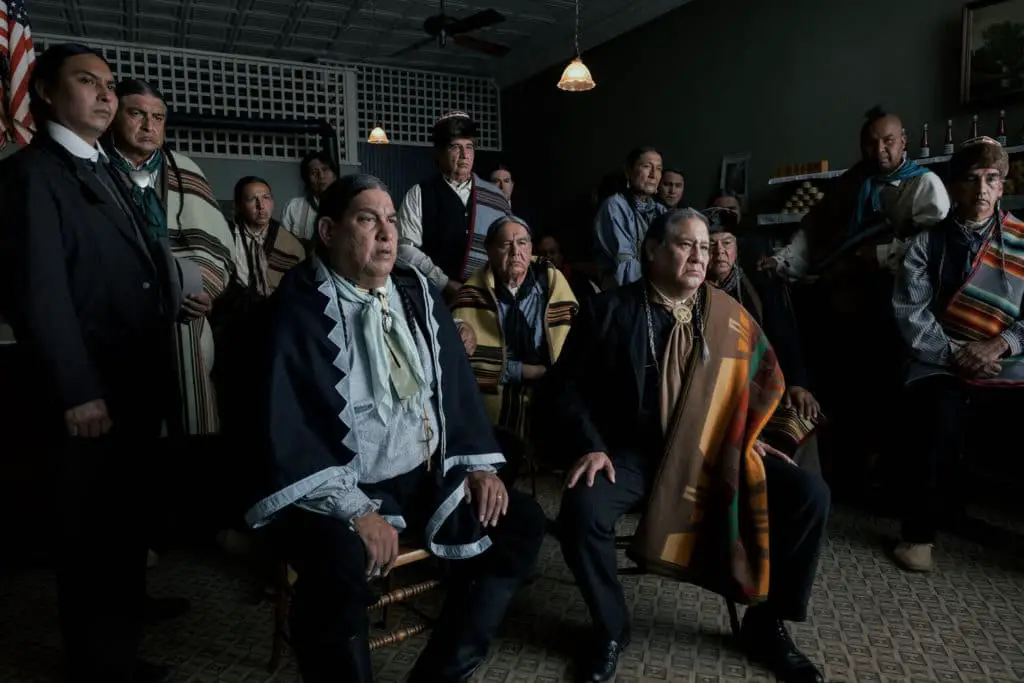
However, after discussions with descendants of the victims and other tribe members, the script was rewritten to emphasize the relationship between oil heiress Molly Berhart and her husband Ernest. The latter was indeed involved in the murder of many of Molly’s family members and may have also poisoned her on her uncle’s orders.
When Ernest and Molly married, they were 24 and 30 years old respectively. It is difficult to say exactly what their feelings for each other really were. According to David Grann, there was enough evidence to indicate that Ernest had genuine feelings for Molly. He studied her native language and cared for her when she suffered from diabetes.
In the screen adaptation, Ernest is presented as a submissive and weak-willed man who is completely obedient to his uncle William Hale. To emphasize this fact, a completely fictional episode appears in the film when the King flogs his nephew Ernest.
In reality, Ernest never said he knew about Molly’s poisoning. As David Grann suggests in Killers of the Flower Moon, perhaps the King didn’t trust his nephew to kill his own wife after all. So Ernest may indeed have been unaware of the poisoning.
William Hale was fifty-one years old at the time of his arrest, while Robert De Niro, who played his role, was eighty years old.
Molly demanded that the authorities investigate the murder of her sister Anna, but most officials didn’t much care for the dead redskin. The Indians hired several private investigators. Most of them were members of the detective agency of William Burns, a famous detective at the time. In reality, no one attacked Burns. Most likely, in the picture his story mixed with the story of the lawyer William Watkins Vaughan. The latter worked closely with private detectives who tried to solve the murders of Indians, but in 1923 he was killed himself. Burns often skirted the law and hired crooks. So it’s not surprising that some of those involved in the investigation were bribed by criminals. The Indians convinced oilman Barn McBride to go to Washington to facilitate a high-level investigation. But he was also killed.

There is a fictional scene in the movie when Molly, along with the other Osages, went to Washington, D.C. to ask for help. In the script, she saw President Calvin Coolidge. But in reality, the trip to the capital never happened. Molly never met with President Coolidge. In reality, the moves in the investigation were prompted by Coolidge’s decision to launch a major crackdown on corruption. He appointed nationally known lawyer Harlan Fiske Stone as Attorney General and Minister of Justice. He in turn appointed officials to conduct anti-corruption investigations. Stone instituted reform at the FBI. The tough John Edgar Hoover was appointed as acting director, who in turn put Tom White in charge of the Osage murder investigation.
Through this investigation, Hoover sought to restore the lost reputation of FBI personnel. Tom White and his team during the investigation were faced with witnesses refusing to give any explanation on matters of interest because of corruption or fear of being punished for it by the corrupt. So the agent decided that most of his colleagues would go undercover. In the movie, though, the FBI agents act quite openly.
White’s team checked each suspect’s alibi. For a while, Byron Burkhart’s seemingly ironclad alibi could not be disproved. Eventually, an elderly farmer revealed that he had seen Byron with Anna. In the movie, he tells agents that he also saw Kelsey Morrison and his wife. The farmer didn’t actually mention them. The agents came upon Kelsey through a long parallel investigation, and Morrison’s identity was finally revealed after his arrest by Ernest Berhart. It turns out that Morrison was also a secret informant for the FBI and was playing a double game, passing information to King. This is where the movie makers simplified the plot.
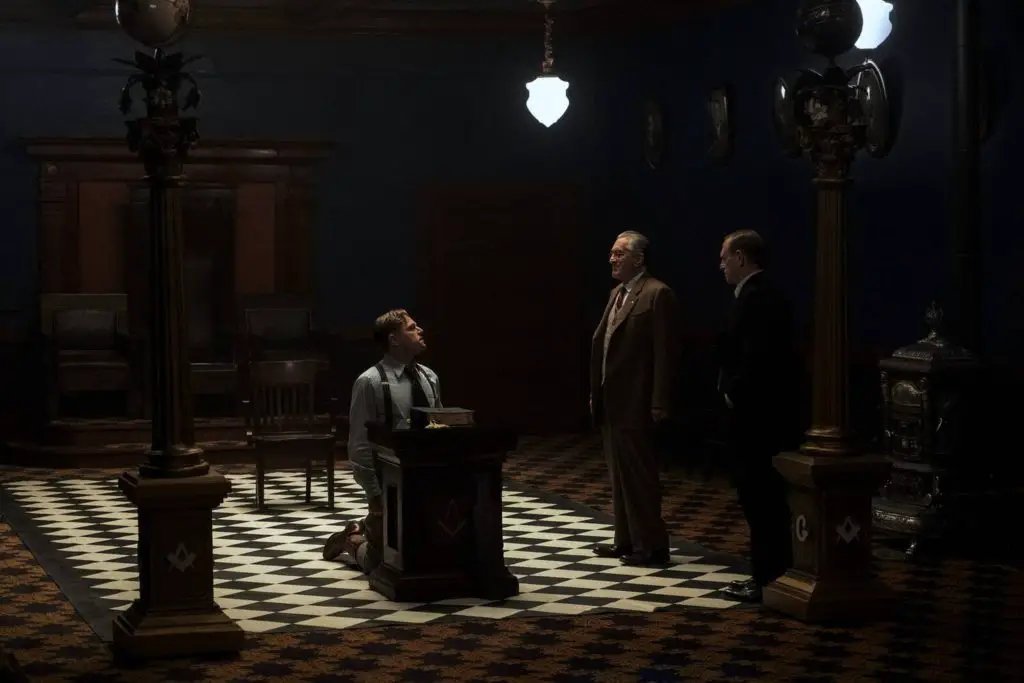
Ernest was interrogated for quite some time after his arrest, but he feared the King more than the authorities. The agents’ reputations hung in the balance, as Hale threatened to present his irrefutable alibi and even involved the press in spreading this information. This was also not shown in the movie. The agents were saved by the testimony of an inmate, Irvin Thomson, nicknamed Blackie, who had Cherokee Indian blood in him and hated Hale and Byron. He characterized them as those who wanted everything without giving anything in return. Blackie and Ernest were not alone together as was shown in the movie. The Indian quite willingly told in the presence of the agents about his connection with the King’s gang. Not immediately, but soon Ernest also confessed to everything.
In court, the first set of jurors had to be removed from duty after evidence was obtained that King had tried to bribe them. Prosecutors had to carefully select jurors to make sure they were incorruptible. The pressure on the court was immense – Hale’s associates used the most extreme measures up to and including an attempt to poison witnesses. The main witness whose testimony the King feared was, of course, Ernest. Hale attempted to help Blackie escape from prison in exchange for killing Ernest. However, the scheme failed.
Just as shown in the movie, one of King’s lawyers convinced Ernest not to testify against Hale. According to White, the impetus for this was that Hale had managed to whisper a few words to his nephew at the trial and thus regain power over him. Ernest was thus “reclassified” as a witness on the defense side. The agents had to refute his accusations of mistreatment of prisoners. Once again from the collapse of the officers of order were saved by new testimony – this time Kelsey Morrison and his ex-wife.
The death of a child did motivate Ernest to change his testimony. However, the conversation in prison between him and King did not really take place. The only place they encountered each other after his arrest was in court.
In reality, after Ernest’s arrest, Molly did not meet him. It is known that even after revealing the truth about the murders of her tribesmen, the girl said that her husband was a good and kind man. She was never able to believe what had happened.

The meaning of the movie Killers of the Flower Moon
So, as in the primary source, David Grann’s book Killers of the Flower Moon, the authors of the movie tried to tell the true story of the killings of the Osage Indians. It turned out to be tragic, but not as large-scale as in reality, where the victims were several dozen Indians – and that’s only those who were killed. The focus is deliberately shifted from the investigation (it is portrayed very simplistically) to the melodramatic line of Ernest and Molly, as well as the line of Ernest and King’s relationship. These are the crux of the movie. And from such a change in the script, the picture only benefited. We saw a tragic and quite realistic story about the nature of evil.
According to the director’s interpretation, the root of evil is greed, stupidity (if not to say “stupidity”) and inability to act and make decisions independently. All this combines the main character Ernest Berhart, impeccably played by Leonardo DiCaprio. In fact, he is a real villain. Ernest is driven by the thirst for profit and instincts, everything else is a variation of them.
The authors do not try to endow his actions with some hidden meaning, and the character himself with positive character traits. As the latter, of course, one could mention his feelings towards his wife and children. But they also seem to be largely instinctive and materialistic. Love, if there really was any, is destroyed by the finale by a systematic and disgusting betrayal.
However, Martin Scorsese himself says in an interview that Ernest in some ways did not realize or did not want to realize that he was killing Molly. He was in the position of a subordinate, obliged to follow orders, and does not think about what he is actually doing.
Indeed, Ernest, as the story progresses, is constantly at Hale’s mercy and does not even try to change anything. He is simply manipulated, and he almost does not realize it. He manages to get out of the vicious circle almost miraculously and thanks to the tragedy of losing his child.
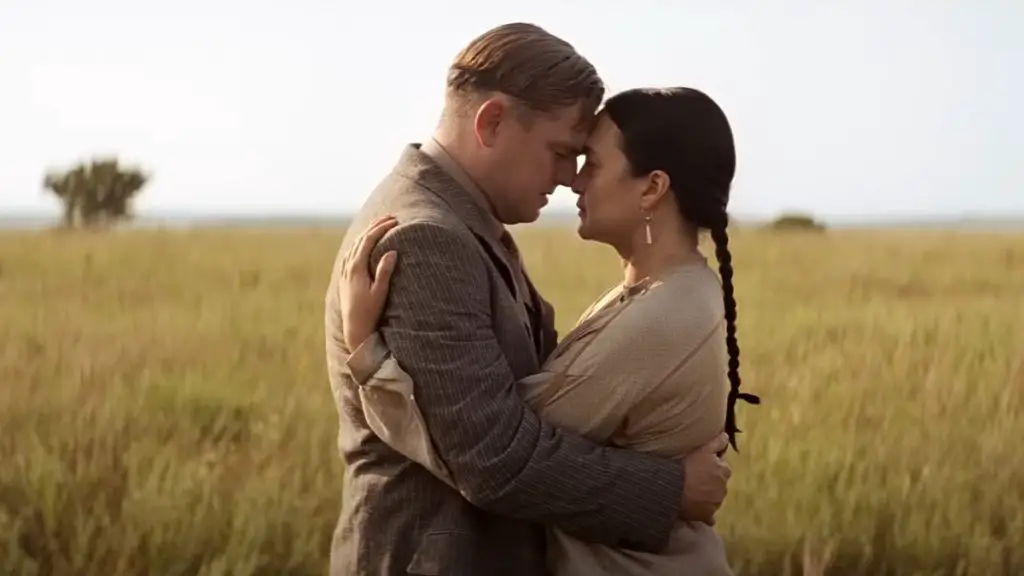
The meaning of the name Killers of the Flower Moon
The title suggests that the movie is about people who kill something beautiful – in the environment (specifically the Indians themselves and their culture) and in themselves (good light feelings that have no place in the cruel world of corruption).
Explanation of the ending of Killers of the Flower Moon
The meaning of the ending of Killers of the Flower Moon is quite straightforward. The director, with the help of a radio play, directly points out that this terrible episode of American history, along with other similar ones, is not at all perceived by the audience as something truly horrifying. The explanation of the ending is as follows: all this tragedy for ordinary people is just a show, which can be enjoyed, over which you can even cry. But to remember forever to avoid repeating the tragedy is out of the question.
The Indians’ dance of the flower moon, which takes place in our time, at the end of the film (the Indians called the flower moon the period of the May full moon, when life on earth is reborn and “picks up color”) is intended to give a small but hope for the best in the future.
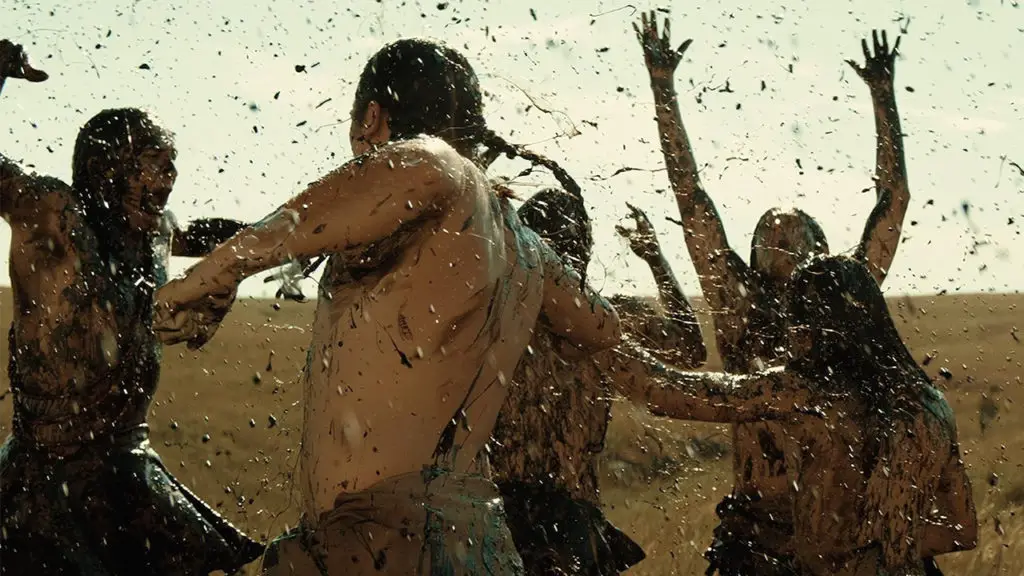
Related movies
- The Irishman (USA, 2019): another epic crime drama from Martin Scorsese;
- The Wolf of Wall Street (USA, 2013): another Martin Scorsese biographical crime drama with an anti-giro played by Leonardo DiCaprio;
- Yellowstone (USA, from 2018): brutal modern western series;
- 1923 (TV series) (USA, from 2022): a prequel to Yellowstone, with events taking place in the twenties of the twentieth century;
- There Will Be Blood (USA, 2007): In the early twentieth century, a successful oilman does everything he can to get even richer.







